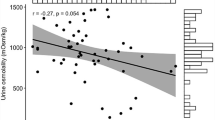Summary
Juveniles of the Estuarine or Saltwater Crocodile,Crocodylus porosus, maintain both osmotic pressure and plasma electrolyte homeostasis along a salinity gradient from fresh water to the sea. In fresh water (FW) the cloacal urine is a clear solution rich in ammonium and bicarbonate and containing small amounts of white precipitated solids with high concentrations of calcium and magnesium. In salt water (SW) the cloacal urine has a much higher proportion of solids, cream rather than white in colour, which are the major route for excretion of potassium in addition to calcium and magnesium. Neither liquid nor solid fractions of the cloacal urine represent a major route for excretion of sodium chloride. The solids are urates and uric acid, and their production probably constitutes an important strategy for water conservation byC. porosus in SW. These data, coupled with natural history observations and the recent identification of lingual salt glands, contribute to the conclusion thatC. porosus is able to live and breed in either fresh or salt water and may be as euryhaline as any reptile.
Similar content being viewed by others
References
Allen GR (1974) The marine crocodile,Crocodylus porosus, from Ponape, Eastern Caroline Islands with notes on food habits of crocodiles from the Palau Archipelago. Copeia 1974:553
Bentley PJ (1976) Osmoregulation in reptiles. In: Gans C, Dawson WR (eds) Biology of the reptilia. Physiology A, vol 5. Academic Press, New York, pp 365–412
Bentley PJ, Schmidt-Nielsen K (1965) Permeability to water and sodium of the crocodilianCaiman sclerops. J Cell Comp Physiol 66:303–309
Coulson RA, Hernandez T (1964) Biochemistry of the alligator. Louisiana State University Press, Baton Rouge
Dantzler WH (1976) Renal function (with special emphasis on nitrogen excretion). In: Gans C, Dawson WR (eds) Biology of the reptilia. Physiology A, vol 5. Academic Press, New York, pp 447–503
Dunson WA (1969) Reptilian salt glands. In: Botelho SY, Brooks FP, Shelley WB (eds) Exocrine glands. Univ of Pennsylvania Press, Philadelphia, pp 83–103
Dunson WA (1970) Some aspects of electrolyte and water balance in three estuarine reptiles, the diamondback terrapin, American and “salt-water” crocodiles. Comp Biochem Physiol 32:161–174
Dunson WA (1976) Salt glands in reptiles. In: Gans C, Dawson WR (eds) Biology of the reptilia. Physiology A, vol 5. Academic Press, New York, pp 413–445
Dunson WA (1979) Control mechanics in reptiles, chap 7. In: Gilles R (ed) Mechanisms of osmoregulation in animals: Maintenance of cell volume. Wiley-Interscience, New York, pp 273–322
Dunson WA, Moll EO (1980) Osmoregulation in sea water of hatchling emydid turtlesCallagur borneoenis from a Malaysian sea beach. J Herpetol 14:31–36
Gilles-Baillien M (1970) Urea and osmoregulation in the diamond-back terrapinMalaclemys centrata centrata (Latreille). J Exp Biol 52:691–697
Grigg GC (1978) Metabolic rate, Q10 and respiratory quotient (RQ) inCrocodylus porosus, and some generalizations about low RQ in reptiles. Physiol Zool 51:354–360
Grigg GC, Cairncross M (1980) Respiratory properties of the blood ofCrocodylus porosus. Respir Physiol 41:367–380
Grigg GC, Gruca M (1979) Possible adaptive significance of low red cell organic phosphates in crocodiles. J Exp Zool 209:161–167
Grigg GC, Taplin LE, Harlow P, Wright J (1981) Survival and growth of hatchling Crocodylus porosus in saltwater without access to fresh drinking water. Oecologia (in press)
Gruca M, Grigg GC (1980) Methemoglobin reduction in crocodile blood: are high levels of met-Hb typical of healthy reptiles? J Exp Zool 213:305–308
Khalil F, Haggag G (1958) Nitrogenous excretion in crocodiles. J Exp Biol 35:552–555
Magnusson WE, Grigg GC, Taylor JA (1978) An aerial survey of potential nesting areas of the Saltwater Crocodile,Crocodylus porosus Schneider, on the North Coast of Arnhem Land, Northern Australia. Aust Wildl Res 5:401–415
Messel H, Wells AG, Green WJ (1979) Surveys of tidal river systems in the Northern Territory of Australia and their corcodile populations. Monograph 7. Pergamon Press, Sydney
Messel H, Vorlicek GC, Wells AG, Green WJ (1981) Surveys of tidal river systems in the Northern Territory of Australia and their crocodile populations. Monograph 1. Pergamon Press Sydney (in press)
Minnich JE, (1979) Reptiles. In: Maloiy GMO (ed) Comparative physiology of osmoregulation in animals. Academic Press, New York, pp 391–641
Neill WT (1971) The last of the ruling reptiles. Columbia University Press, New York
Nie NH, Hadlai Hull C, Jenkins JG, Steinbrenner K, Bent DH (1975) Statistical package for the social sciences. McGraw-Hill, New York
Schmidt-Nielsen K (1975) Animal physiology; adaptation and environment. Cambridge University Press, London
Schmidt-Nielsen B, Skadhauge E (1967) Function of the excretory system of the crocodile (Crocodylus acutus). Am J Physiol 212:973–980
Taplin LE, Grigg GC Salt glands in the tongue of the estuarine crocodileCrocodylus porosus. Science (in press)
Taylor JA (1977) The foods and feeding habits of sub-adultCrocodylus porosus Schneider, in Northern Australia (Crocodilia: Reptilia). MSc thesis, University of Sydney
Taylor JA (1979) The foods and feeding habits of subadultCrocodylus porosus Schneider in North Australia. Aust Wildl Res 6:347–359
Webb GJW, Messel H (1977) Crocodile capture techniques. J Wildl Manage 41:572–575
Webb GJW, Messel H (1978) Movement and dispersal patterns ofCrocodylus porosus in some rivers of Arnhem Land, Northern Australia. Aust Wildl Res 5:263–283
Author information
Authors and Affiliations
Rights and permissions
About this article
Cite this article
Grigg, G.C. Plasma homeostasis and cloacal urine composition inCrocodylus porosus caught along a salinity gradient. J Comp Physiol B 144, 261–270 (1981). https://doi.org/10.1007/BF00802765
Accepted:
Issue Date:
DOI: https://doi.org/10.1007/BF00802765



